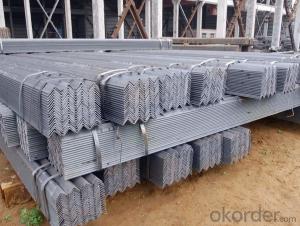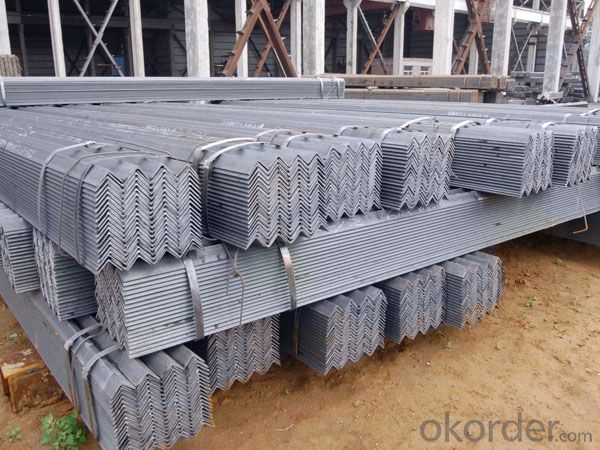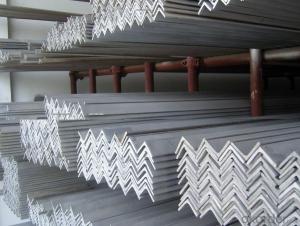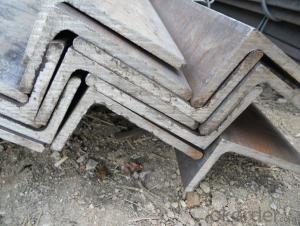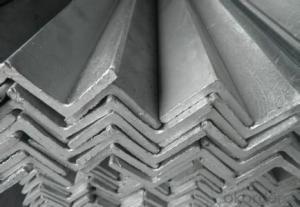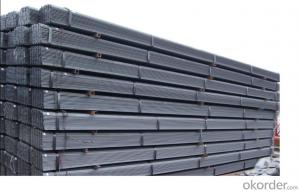Equal Angle Steel or Unequal Angle Steel 20mm-250mm
- Loading Port:
- Tianjin
- Payment Terms:
- TT OR LC
- Min Order Qty:
- 25 m.t.
- Supply Capability:
- 20000000 m.t./month
OKorder Service Pledge
OKorder Financial Service
You Might Also Like
Product Description:
OKorder is offering high quality Hot Rolled Steel I-Beams at great prices with worldwide shipping. Our supplier is a world-class manufacturer of steel, with our products utilized the world over. OKorder annually supplies products to European, North American and Asian markets. We provide quotations within 24 hours of receiving an inquiry and guarantee competitive prices.
Product Applications:
According to the needs of different structures, Angle can compose to different force support component, and also can be the connections between components. It is widely used in various building structures and engineering structures such as roof beams, bridges, transmission towers, hoisting machinery and transport machinery, ships, industrial furnaces, reaction tower, container frame and warehouse etc
Product Advantages:
OKorder's Steel I-Beams are durable, strong, and resist corrosion.
Main Product Features:
· Premium quality
· Prompt delivery & seaworthy packing (30 days after receiving deposit)
· Corrosion resistance
· Can be recycled and reused
· Mill test certification
· Professional Service
· Competitive pricing
Product Specifications:
Manufacture: Hot rolled
Grade: Q195 – 235
Certificates: ISO, SGS, BV, CIQ
Length: 6m – 12m, as per customer request
Packaging: Export packing, nude packing, bundled
Sizes: 25mm-250mm | ||||||||||
a*t | ||||||||||
25*2.5-4.0 | 70*6.0-9.0 | 130*9.0-15 | ||||||||
30*2.5-6.6 | 75*6.0-9.0 | 140*10-14 | ||||||||
36*3.0-5.0 | 80*5.0-10 | 150*10-20 | ||||||||
38*2.3-6.0 | 90*7.0-10 | 160*10-16 | ||||||||
40*3.0-5.0 | 100*6.0-12 | 175*12-15 | ||||||||
45*4.0-6.0 | 110*8.0-10 | 180*12-18 | ||||||||
50*4.0-6.0 | 120*6.0-15 | 200*14-25 | ||||||||
60*4.0-8.0 | 125*8.0-14 | 250*25 | ||||||||
FAQ:
Q1: How soon can we receive the product after purchase?
A1: Within three days of placing an order, we will begin production. The specific shipping date is dependent upon international and government factors, but is typically 7 to 10 workdays.
Q2: What makes stainless steel stainless?
A2: Stainless steel must contain at least 10.5 % chromium. It is this element that reacts with the oxygen in the air to form a complex chrome-oxide surface layer that is invisible but strong enough to prevent further oxygen from "staining" (rusting) the surface. Higher levels of chromium and the addition of other alloying elements such as nickel and molybdenum enhance this surface layer and improve the corrosion resistance of the stainless material.
Q3: Can stainless steel rust?
A3: Stainless does not "rust" as you think of regular steel rusting with a red oxide on the surface that flakes off. If you see red rust it is probably due to some iron particles that have contaminated the surface of the stainless steel and it is these iron particles that are rusting.
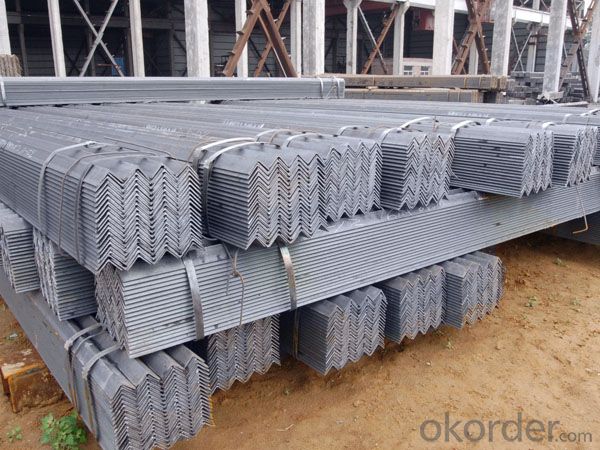
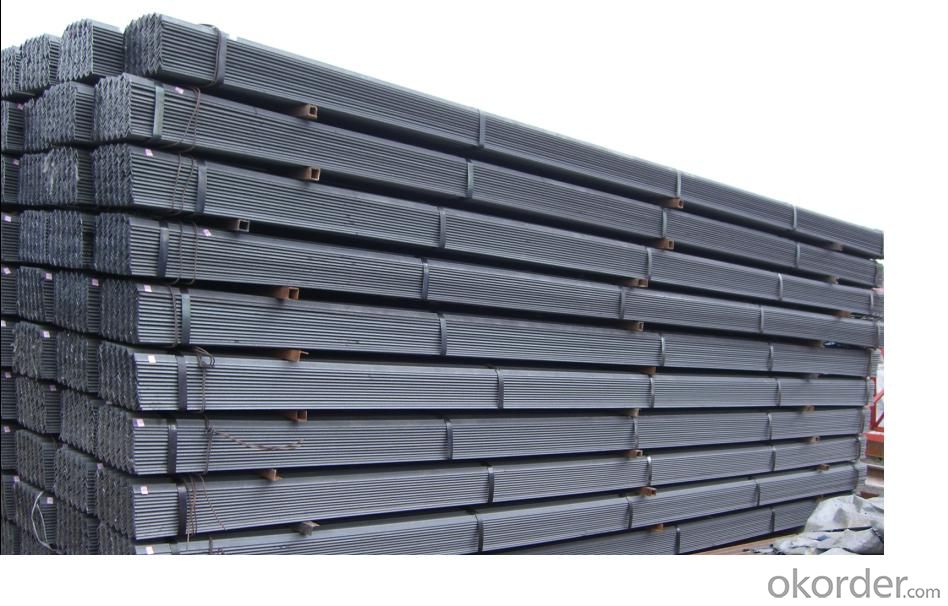
- Q: What are the different types of steel angles used in agriculture?
- There are several types of steel angles used in agriculture, including equal angles, unequal angles, and L-shaped angles. These angles are commonly used in the construction of agricultural buildings, equipment, and fencing.
- Q: What is the maximum allowable torsional buckling stress for a steel angle?
- The maximum allowable torsional buckling stress for a steel angle depends on several factors, including the material properties of the steel, the geometry of the angle, and the applied load conditions. In general, torsional buckling occurs when a member twists under an applied torque, resulting in a loss of stability and potential failure. To prevent torsional buckling, design codes and standards provide guidelines and formulas to determine the maximum allowable stress. For example, the American Institute of Steel Construction (AISC) provides a formula for the calculation of torsional buckling stress in their Steel Construction Manual. This formula takes into account the section properties of the angle, such as the moment of inertia and the radius of gyration, along with the slenderness ratio and the effective length of the member. It is important to note that the maximum allowable torsional buckling stress varies depending on the specific design requirements and safety factors used in the design process. Therefore, it is essential to refer to the relevant design codes and consult with a structural engineer to determine the specific maximum allowable torsional buckling stress for a given steel angle in a particular design situation.
- Q: What are the different types of steel angles used in engineering?
- In engineering, there are several different types of steel angles that are commonly used. These angles are typically made from hot-rolled steel and are available in various sizes and dimensions to suit different applications. Some of the different types of steel angles used in engineering include: 1. Equal angles: These angles have equal sides and are commonly used for structural purposes, such as supporting beams or columns. They provide stability and strength to the structure and are often used in construction projects. 2. Unequal angles: As the name suggests, unequal angles have different length sides. These angles are often used in applications where one side needs to be longer or shorter than the other, such as bracing or framing. 3. L-shaped angles: L-shaped angles have one side longer than the other, forming an L-shape. These angles are commonly used in construction to provide support and reinforcement, such as for corners, joints, or connections. 4. Structural angles: Structural angles are specifically designed to bear heavy loads and provide structural stability. They are commonly used in building frame structures, bridges, or other load-bearing applications. 5. Stainless steel angles: Stainless steel angles are made from stainless steel, which offers excellent corrosion resistance and durability. These angles are often used in environments where rust or corrosion may be a concern, such as marine applications or food processing facilities. 6. Galvanized steel angles: Galvanized steel angles are coated with a layer of zinc to provide corrosion resistance. These angles are commonly used in outdoor applications or environments where exposure to moisture or harsh conditions is expected. 7. Perforated steel angles: Perforated steel angles have holes or perforations along their length, allowing for improved ventilation or drainage. These angles are often used in applications where airflow or water drainage is required, such as in HVAC systems or outdoor structures. Overall, the choice of steel angle depends on the specific requirements of the engineering project. Factors such as load-bearing capacity, resistance to corrosion, and aesthetic considerations play a crucial role in selecting the appropriate type of steel angle for a particular application.
- Q: Are steel angles susceptible to rusting?
- Yes, steel angles can be susceptible to rusting. Steel is primarily made of iron, and when exposed to moisture and oxygen, it undergoes a chemical reaction called oxidation, resulting in the formation of iron oxide, commonly known as rust. The rate of rusting can be influenced by various factors such as the quality of the steel, the presence of protective coatings, exposure to corrosive substances, and the level of humidity. Therefore, if steel angles are not properly protected or maintained, they can rust over time. Regular inspection, cleaning, and applying protective coatings can help prevent or slow down the rusting process and extend the lifespan of steel angles.
- Q: What is the fire resistance rating of steel angles?
- The fire resistance of steel angles relies on several factors, including the angle's size and thickness, the type of steel employed, and the specific fire protection measures implemented. Steel possesses inherent fire resistance due to its high melting point and low thermal conductivity. Nevertheless, the fire resistance can be improved by applying fireproofing materials, such as intumescent coatings or fire-resistant boards, to the steel angles. By providing insulation and slowing down heat transfer to the steel, these fire protection measures can significantly augment the fire resistance of steel angles. The specific fire resistance rating may differ depending on the thickness and type of fireproofing materials employed. For instance, a steel angle coated with a particular fireproofing substance may have a fire resistance rating of 60 minutes, signifying its ability to withstand fire exposure for up to 60 minutes without compromising its structural integrity. To determine the specific fire resistance requirements for steel angles in a specific application, it is crucial to refer to local building codes, regulations, and fire safety standards. These standards can offer guidance on the necessary fire protection measures and the minimum fire resistance ratings that must be met in different construction scenarios.
- Q: What are the limitations of using steel angles in high-temperature applications?
- The susceptibility of steel angles to thermal expansion is one limitation when using them in high-temperature applications. Similar to other materials, steel expands when heated and contracts when cooled. This characteristic can cause dimensional changes in the steel angles, potentially impacting their structural integrity and performance. Another limitation is the potential weakening of steel angles at elevated temperatures. As the temperature rises, the steel can undergo tempering, a process that reduces its hardness and increases its ductility. This can result in reduced load-bearing capacity and increased vulnerability to deformation or failure under high loads or stresses. Furthermore, steel angles are prone to oxidation and corrosion at high temperatures. When exposed to oxygen and moisture in the air, steel can form rust or iron oxide. This can weaken the steel angles and compromise their structural integrity, especially in environments with high humidity or aggressive chemical agents. In addition, steel angles may experience creep when subjected to high temperatures and constant loads. Creep refers to the gradual deformation or elongation of a material under constant stress over time. This can lead to permanent deformation and jeopardize the structural stability of the steel angles. Lastly, the thermal conductivity of steel must be carefully considered in the design and fabrication of steel angles for high-temperature applications. Steel has relatively high thermal conductivity, meaning it can quickly transfer heat. This characteristic can result in uneven heating and cooling of the steel angles, potentially causing stress concentrations or thermal gradients that could impact their performance. Given these limitations, it is crucial to thoroughly assess the suitability of steel angles for high-temperature applications and explore alternative materials or design adjustments to ensure optimal performance and safety.
- Q: Are steel angles resistant to wind loads?
- Yes, steel angles are resistant to wind loads. Steel angles are commonly used in construction for their strength and stability. When properly designed and installed, steel angles provide structural support and can effectively resist the forces exerted by wind. The shape and geometry of steel angles provide rigidity and stability, making them capable of withstanding wind loads without significant deformation or failure. Additionally, steel angles can be reinforced and connected to other structural elements, further enhancing their resistance to wind loads.
- Q: 304 what does angle iron stand for?
- 304 is a versatile stainless steel which is widely used in the manufacture of equipment and parts requiring good overall performance (corrosion resistance and formability). 304 stainless steel is a brand of stainless steel produced according to the ASTM standard in the United states. 304 chromium 19%, containing nickel 9%.
- Q: What is the process of punching holes in steel angles?
- The process of punching holes in steel angles involves several steps. First, the steel angle is measured and marked according to the desired hole placement. This is typically done using a measuring tape and a marker or scribe. Once the markings are made, the steel angle is clamped securely onto a work table or a specialized punching machine. This ensures that the angle remains stable during the hole punching process. Next, a punch and die set specifically designed for steel angles is selected. The punch is the tool that creates the hole, while the die supports the material and helps to produce clean and accurate holes. The punch and die set is aligned with the marked location on the steel angle. This is done by positioning the punch directly above the desired hole and ensuring that it is centered and level. The die is placed underneath the angle to provide support. Using a hydraulic or mechanical press, pressure is applied to the punch. This causes it to penetrate through the steel angle, creating a hole. The force applied depends on the thickness and hardness of the steel angle, as well as the size of the hole being punched. After the hole is punched, the punch and die set is removed from the steel angle. The angle is then inspected to ensure that the hole is clean and free from any burrs or deformations. If necessary, any imperfections can be smoothed out using a deburring tool or sandpaper. Overall, the process of punching holes in steel angles requires careful measurement, marking, clamping, alignment, and the use of specialized tools. It is important to follow proper safety procedures and use appropriate protective equipment, such as gloves and goggles, to prevent injury during the process.
- Q: Can steel angles be used in agricultural or farm applications?
- Yes, steel angles can be used in agricultural or farm applications. Steel angles are versatile and durable structural components that are commonly used in various industries, including agriculture. They can be utilized in farm equipment, such as machinery frames, trailers, and fences. Steel angles are ideal for these applications due to their strength and stability, which can withstand heavy loads and harsh weather conditions. Additionally, they can be easily welded, bolted, or fastened together, allowing for easy customization and construction of various agricultural structures. Overall, steel angles are a reliable and practical choice for agricultural and farm applications.
Send your message to us
Equal Angle Steel or Unequal Angle Steel 20mm-250mm
- Loading Port:
- Tianjin
- Payment Terms:
- TT OR LC
- Min Order Qty:
- 25 m.t.
- Supply Capability:
- 20000000 m.t./month
OKorder Service Pledge
OKorder Financial Service
Similar products
Hot products
Hot Searches
Related keywords
